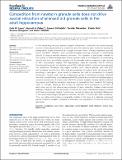| dc.contributor.author | Lopez, Carla M. | |
| dc.contributor.author | Pelkey, Kenneth A. | |
| dc.contributor.author | Chittajallu, Ramesh | |
| dc.contributor.author | Nakashiba, Toshiaki | |
| dc.contributor.author | Toth, Katalin | |
| dc.contributor.author | Tonegawa, Susumu | |
| dc.contributor.author | McBain, Chris J. | |
| dc.date.accessioned | 2013-03-06T17:59:20Z | |
| dc.date.available | 2013-03-06T17:59:20Z | |
| dc.date.issued | 2012-11 | |
| dc.date.submitted | 2012-08 | |
| dc.identifier.issn | 1662-5110 | |
| dc.identifier.uri | http://hdl.handle.net/1721.1/77581 | |
| dc.description.abstract | In the developing nervous system synaptic refinement, typified by the neuromuscular junction where supernumerary connections are eliminated by axon retraction leaving the postsynaptic target innervated by a single dominant input, critically regulates neuronal circuit formation. Whether such competition-based pruning continues in established circuits of mature animals remains unknown. This question is particularly relevant in the context of adult neurogenesis where newborn cells must integrate into preexisting circuits, and thus, potentially compete with functionally mature synapses to gain access to their postsynaptic targets. The hippocampus plays an important role in memory formation/retrieval and the dentate gyrus (DG) subfield exhibits continued neurogenesis into adulthood. Therefore, this region contains both mature granule cells (old GCs) and immature recently born GCs that are generated throughout adult life (young GCs), providing a neurogenic niche model to examine the role of competition in synaptic refinement. Recent work from an independent group in developing animals indicated that embryonically/early postnatal generated GCs placed at a competitive disadvantage by selective expression of tetanus toxin (TeTX) to prevent synaptic release rapidly retracted their axons, and that this retraction was driven by competition from newborn GCs lacking TeTX. In contrast, following 3–6 months of selective TeTX expression in old GCs of adult mice we did not observe any evidence of axon retraction. Indeed ultrastructural analyses indicated that the terminals of silenced GCs even maintained synaptic contact with their postsynaptic targets. Furthermore, we did not detect any significant differences in the electrophysiological properties between old GCs in control and TeTX conditions. Thus, our data demonstrate a remarkable stability in the face of a relatively prolonged period of altered synaptic competition between two populations of neurons within the adult brain. | en_US |
| dc.description.sponsorship | National Institutes of Health (U.S.) (Grant R01-MH078821) | en_US |
| dc.description.sponsorship | National Institutes of Health (U.S.) (Grant P50-MH58880) | en_US |
| dc.language.iso | en_US | |
| dc.publisher | Frontiers Research Foundation | en_US |
| dc.relation.isversionof | http://dx.doi.org/10.3389/fncir.2012.00085 | en_US |
| dc.rights | Article is made available in accordance with the publisher's policy and may be subject to US copyright law. Please refer to the publisher's site for terms of use. | en_US |
| dc.source | Frontiers Research Foundation | en_US |
| dc.title | Competition from newborn granule cells does not drive axonal retraction of silenced old granule cells in the adult hippocampus | en_US |
| dc.type | Article | en_US |
| dc.identifier.citation | Lopez, Carla M. et al. “Competition from Newborn Granule Cells Does Not Drive Axonal Retraction of Silenced Old Granule Cells in the Adult Hippocampus.” Frontiers in Neural Circuits 6 (2012). ©2012 Frontiers Media S. A. | en_US |
| dc.contributor.department | Massachusetts Institute of Technology. Department of Biology | en_US |
| dc.contributor.department | Picower Institute for Learning and Memory | en_US |
| dc.contributor.department | RIKEN-MIT Center for Neural Circuit Genetics | en_US |
| dc.contributor.mitauthor | Nakashiba, Toshiaki | |
| dc.contributor.mitauthor | Tonegawa, Susumu | |
| dc.relation.journal | Frontiers in Neural Circuits | en_US |
| dc.eprint.version | Final published version | en_US |
| dc.type.uri | http://purl.org/eprint/type/JournalArticle | en_US |
| eprint.status | http://purl.org/eprint/status/PeerReviewed | en_US |
| dspace.orderedauthors | Lopez, Carla M.; Pelkey, Kenneth A.; Chittajallu, Ramesh; Nakashiba, Toshiaki; Tóth, Katalin; Tonegawa, Susumu; McBain, Chris J. | en |
| dc.identifier.orcid | https://orcid.org/0000-0003-2839-8228 | |
| mit.license | PUBLISHER_POLICY | en_US |
| mit.metadata.status | Complete | |
